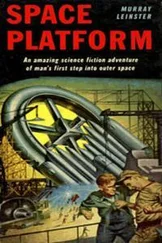He set the signal–torpedo over that cone. The entire set–up was under six feet tall, and the coolie–hat cones were no more than eighteen inches in diameter. He said flatly:
"I'm all ready."
The hand and arm of a space–suited figure lifted, for attention. Dabney's voice came worriedly from the headphones of every suit:
"I wish it understood," he said in some agitation, "that this first attempted application of my discovery is made with my consent, but that I am not aware of the mechanical details. As a scientist, my work has been in pure science. I have worked for the advancement of human knowledge, but the technological applications of my discovery are not mine. Still—if this device does not work, I will take time from my more important researches to inquire into what part of my discovery has been inadequately understood and applied. It may be that present technology is not qualified to apply my discovery—"
Jones said without emotion—but Cochrane could imagine his poker–faced expression inside his helmet:
"That's right. I consulted Mr. Dabney about the principles, but the apparatus is my doing, I take the responsibility for that!"
Then Cochrane added with pleasant irony:
"Since all this is recorded, Mr. Dabney can enlarge upon his disinterest later. Right now, we can go ahead. Mr. Dabney disavows us unless we are successful. Let us let it go at that." Then he said: "The observatory's set to track?"
A muffled voice said boredly, by short–wave from the observatory up on the crater's rim:
" We're ready. Visual and records, and we've got the timers set to clock the auto–beacon signals as they come in. "
The voice was not enthusiastic. Cochrane had had to put up his own money to have the nearside lunar observatory put a low–power telescope to watch the rocket's flight. In theory, this distress–rocket should make a twenty–mile streak of relatively long–burning red sparks. A tiny auto–beacon in its nose was set to send microwave signals at ten–second intervals. On the face of it, it had looked like a rather futile performance.
"Let's go," said Cochrane.
He noted with surprise that his mouth was suddenly dry. This affair was out of all reason. A producer of television shows should not be the person to discover in an abstruse scientific development the way to reach the stars. A neurotic son–in–law of an advertising tycoon should not be the instrument by which the discovery should come about. A psychiatrist should not be the means of associating Jones—a very junior physicist with no money—and Cochrane and the things Cochrane was prepared to bring about if only this unlikely–looking gadget worked.
"Jones," said Cochrane with a little difficulty, "let's follow an ancient tradition. Let Babs christen the enterprise by throwing the switch."
Jones pointed there in the shadow of the crater–wall, and Babs moved to the switch he indicated. She said absorbedly:
"Five, four, three, two, one—"
She threw the switch. There was a spout of lurid red flame.
The rocket vanished.
It vanished. It did not rise, visibly. It simply went away from where it was, with all the abruptness of a light going out. There was a flurry of the most brilliant imaginable carmine flame. That light remained. But the rocket did not so much rise as disappear.
Cochrane jerked his head up. He was close to the line of the rocket's ascent. He could see a trail of red sparks which stretched to invisibility. It was an extraordinarily thin line. The separate flecks of crimson light which comprised it were distant in space. They were so far from each other that the signal–rocket was a complete failure as a device making a streak of light that should be visible.
The muffled voice in the helmet–phones said blankly:
" Hey! What'd you do to that rocket? "
The others did not move. They seemed stunned. The vanishing of the rocket was no way for a rocket to act. In all expectation, it should have soared skyward with a reasonable velocity, and should have accelerated rather more swiftly from the moon's surface than it would have done from Earth. But it should have remained visible during all its flight. Its trail should have been a thick red line. Instead, the red sparks were so far separated—the trail was so attenuated that it was visible only from a spot near its base. The observatory voice said more blankly still:
" Hey! I've picked up the trail! I can't see it nearby, but it seems to start, thin, about fifty miles up and go on away from there! That rocket shouldn't ha' gone more than twenty miles! What happened? "
" Watch for the microwave signals ," said Jones' voice in Cochrane's headphones.
The voice from the observatory squeaked suddenly. This was not one of the highly–placed astronomers, but part of the mechanical staff who'd been willing to do an unreasonable chore for pay.
" Here's the blip! It's crazy! Nothing can go that fast! "
And then in the phones there came the relayed signal of the auto–beacon in the vanished rocket. The signal–sound was that of a radar pulse, beginning at low pitch and rising three octaves in the tenth of a second. At middle C—the middle of the range of a piano—there was a momentary spurt of extra volume. But in the relayed signal that louder instant had dropped four tones. Cochrane said crisply:
"Jones, what speed would that be?"
" It'd take a slide–rule to figure it ," said Jones' voice, very calmly, " but it's faster than anything ever went before. "
Cochrane waited for the next beep. It did not come in ten seconds. It was easily fifteen. Even he could figure out what that meant! A signal–source that stretched ten seconds of interval at source to fifteen at reception …
The voice from the observatory wailed:
" It's crazy! It can't be going like that! "
They waited. Fifteen seconds more. Sixteen. Eighteen. Twenty. The beep sounded. The spurt of sound had dropped a full octave. The signal–rocket, traveling normally, might have attained a maximum velocity of some two thousand feet per second. It was now moving at a speed which was an appreciably large fraction of the speed of light. Which was starkly impossible. It simply happened to be true.
They heard the signal once more. The observatory's multiple–receptor receiver had been stepped up to maximum amplification. The signal was distinct, but very faint indeed. And the rocket was then traveling—so it was later computed—at seven–eighths of the speed of light. Between the flat cone on the front of the distress–torpedo, and the flat cone on the ground, a field of force existed. The field was not on the back surface of the torpedo's cone, but before the front surface. It went back to the moon from there, so all the torpedo and its batteries were in the columnar stressed space. And an amount of rocket–push that should have sent the four–foot torpedo maybe twenty miles during its period of burning, had actually extended its flight to more than thirty–seven hundred miles before the red sparks were too far separated to be traced any farther, and by then had kicked the torpedo up impossibly close to light–speed.
In a sense, the Dabney field had an effect similar to the invention of railways. The same horsepower moved vastly more weight faster, over steel rails, than it could haul over a rutted dirt road. The same rocket–thrust moved more weight faster in the Dabney field than in normal space. There would be a practical limit to the speed at which a wagon could be drawn over a rough road. The speed of light was a limit to the speed of matter in normal space. But on a railway the practical speed at which a vehicle could travel went up from three miles an hour to a hundred and twenty. In the Dabney field it was yet to be discovered what the limiting velocity might be. But old formulas for acceleration and increase–of–mass–with–velocity simply did not apply in a Dabney field.
Читать дальше






